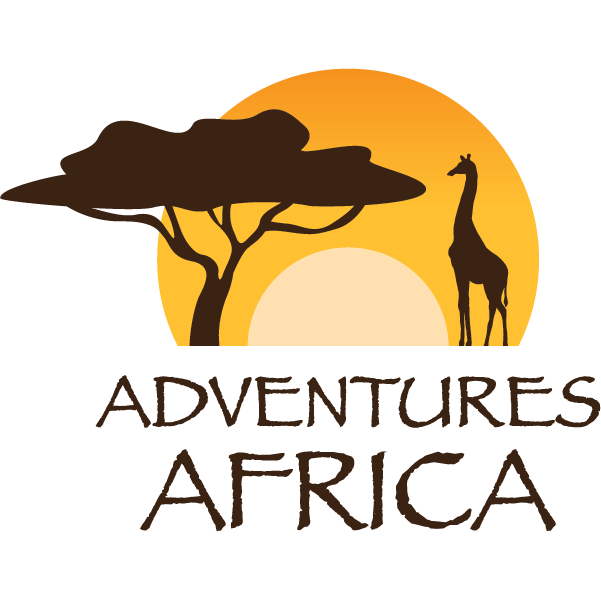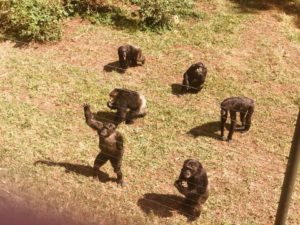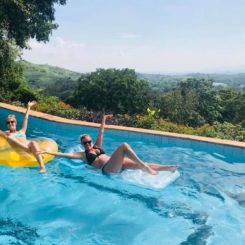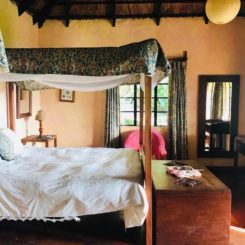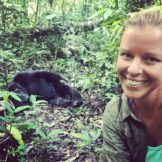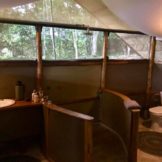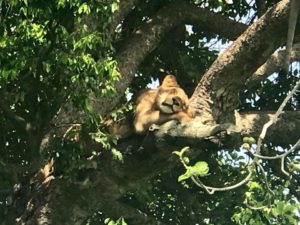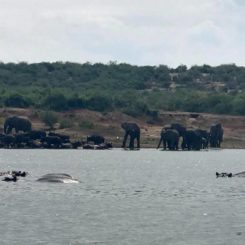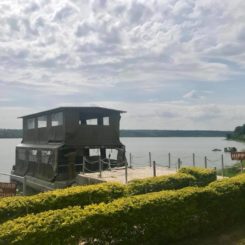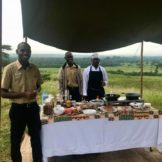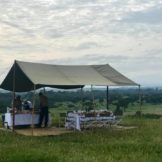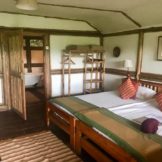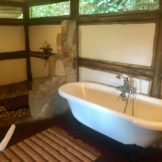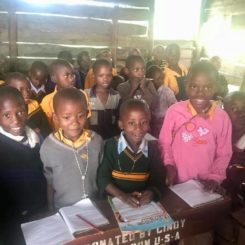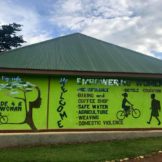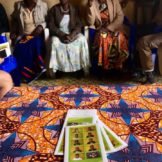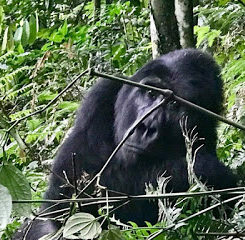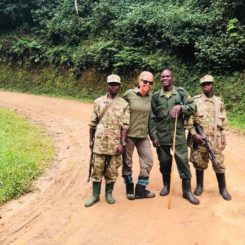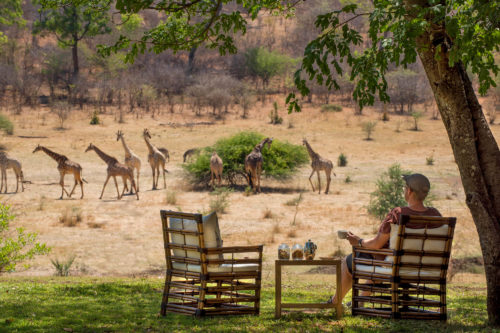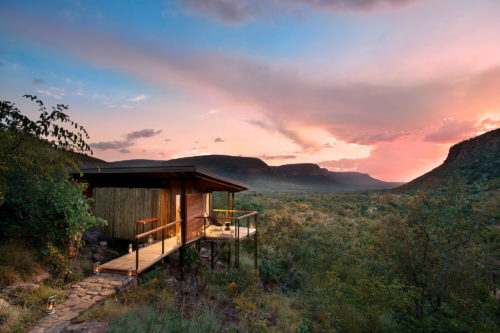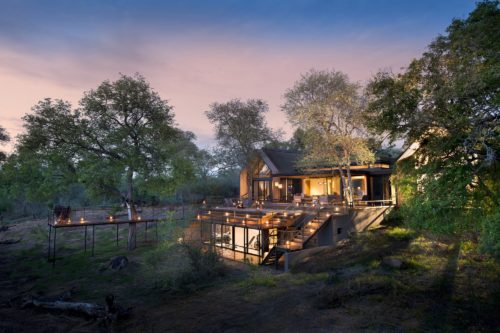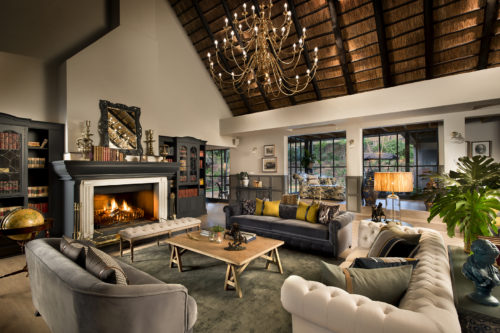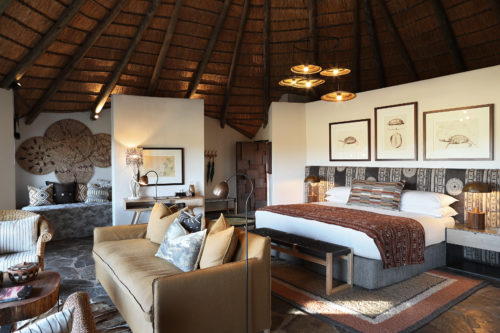Uganda Safari: Gorillas, Chimpanzees & Game – forests, savannah & rivers
by Melissa Schreiber
My 8-day safari with Wild Frontiers is something I will never forget. It included a thrilling visit deep in the jungle with the Mountain Gorillas in Bwindi Impenetrable Forest National Park, chimpanzee tracking in Kibale National Park, multiple game drives in Queen Elizabeth National Park, including seeing the famous tree climbing lions, a boat cruise on the Kazinga Channel, a visit to Ngamba Island Chimpanzee Sanctuary on beautiful Lake Victoria and an inspiring community walk throughout the village of Bwindi.
Days 1-2: Boma Guest Lodge, Entebbe
Day 1
I arrived at Entebbe International Airport after about 30 hours of flying and was transferred to the Boma Guest Lodge for 2 nights. The Boma is a small, family-run guest house located in the suburbs of Entebbe 15 minutes from the airport. A converted residential home, it offers quiet, relaxed and peaceful atmosphere. Each suite is uniquely decorated and I had my own veranda. They had great meals, a welcoming bar area and was surrounded by a large garden, private swimming pool and large patio boasting beautiful views toward Lake Victoria.
The town of Entebbe is a small, quiet town located on the shores of Lake Victoria (2ndlargest lake in the world shared by 4 countries) and is easy to explore on foot or local transport known as “boda bodas” (local taxis). While in town, you can visit local markets to buy clothes and crafts, curio shops for souvenirs, and the Botanical Gardens on Lake Victoria where you can walk among beautiful trees, watch monkeys moving through the canopy above, and spot many indigenous bird species. Entebbe has a wide variety of restaurants serving many different cuisines as well as several bars and clubs where you can sample the local beer, catch a game of football and chat with the local Ugandans, known for their open and friendly nature.
Day 2
I took a 1-hour boat trip over to Ngamba Island Chimpanzee Sanctuary. This sanctuary was established as a combined national and international initiative and a globally recognized collaborative conservation effort. The goal is geared towards developing and implementing a long-term strategy for conservation of chimpanzees and their habitat, with the immediate purpose of establishing a chimpanzee sanctuary on Ngamba Island in Lake Victoria.
Activities on the island included learning about the welfare of the individual captive chimpanzees entrusted to its care, long-term management of a sanctuary for confiscated chimps that can’t be returned to the wild, intervention to assist individuals in the wild when deemed necessary, conservation education with a emphasis on chimpanzees, ecotourism, community participation and capacity building through training, and building viable national, regional and international partnerships on chimpanzee conservation. Watching the chimps eat like humans made me realize that they really are 98.7% of same DNA as us…
Days 3 – 4: Ndali Lodge, Fort Portal
Day 3
My Ugandan adventure on day 3 included a long drive from Entebbe to Ndali Lodge in Fort Portal. The drive takes between 5-6 hours and passes through trading centers, towns, rural villages on a tarmac road. We call the drive and “African massage” because of the bumps.
The next 2 nights were spent at the beautiful Ndali Lodge. This peaceful lodge sits between two crater lakes, with spectacular views of the surrounding area. All 8 cottages are spacious and have their own private bathtubs and verandas with views of the Rwenzori Mountains. 4 poster beds, draped in mosquito nets and decorated with locally made crafts give each cottage an individual feel. At night, the lodge is lit with lanterns and candles, including beautiful chandeliers above the central dining area, creating a very peaceful atmosphere for dining, relaxing and chatting with other guests.
These 2 days were spent in the Kibale area to go chimpanzee tracking in the Kibale Forest, one of Uganda’s enchanting forested parks. The park contains pristine lowland tropical rainforest, mountain forest, and a mixed tropical deciduous forest. In addition to forest land, there are areas of grassland and swamps also. The forest is rich with amazing wildlife but most noted for its primate population. Some of these primates included a red-tailed monkey, diademed monkey, baboons, family of chimpanzees and black and white colobus monkeys. Some of the other mammals I saw included the bushbuck, Harvey’s red duiker, blue duiker, a bush pig, and African civet. This is in addition to buffalo, waterbuck, hippo, warthog, and giant forest hogs hanging out. The birdlife in the forest and grasslands of the forest is also abundant with almost 300 species being identified here. In addition, there are 144 species of butterflies in the park and a diverse population of moths and other insects. A system of trails has been developed within the park, and tour guides are available to guide visitors beyond the chimpanzee trekking.
Day 4
We went Chimpanzee Tracking through the forest with the lead guide and legend called Silver. We got extremely lucky because retiring Silver has been at this park from the start and all the chimps know him well. This day started with my group walking down to the Kibale Forest National Parks’ headquarters to meet Silver. The forest was alive with noise from our first steps and I was lucky enough to see the habituated chimps within 45 minutes into the trek. I was lucky enough to catch many of them fighting, nursing, resting, interacting and eating.
Days 5-6: Ishasha Wilderness Camp in Queen Elizabeth National Park
Day 5
On day 5, we leave behind the crater lakes of Ndali and drive to the savannahs of Queen Elizabeth National Park. In the Mweya area of Queen Elizabeth National Park, it’s rich with wildlife in addition to Uganda’s unique and strange Euphorbia, or “candelabra” tree. The many nearby crater lakes and mountain ranges provide a beautiful backdrop for the journey.
The next 2 nights were spent at the beautiful Ishasha Wilderness Camp. This exclusive tented camp offers the only luxury accommodation in the remote southern sector of Queen Elizabeth National Park and is ideally located between Bwindi and the Mweya area of the park. The camp has 10 luxurious safari tents, with each spacious en-suite tent offering its own private dressing area, hot water “bush” shower and eco-friendly flush toilet. A central traditionally thatched dining and lounge area provides guests with a relaxing environment in which to enjoy sundowners, meals and after dinner chats around the fire.
Queen Elizabeth National Park spreads over 1,978sq km in the western arm of the Great Rift Valley and is home to a wide variety of wildlife and many species of birds. With both a riverine and savannah habitat, the park includes the southern Ishasha area with the massive Maramagambo, one of the largest surviving natural forests in Uganda. The northern Mweya area, traversed by the equator and dominated by the scenery of crater lakes, is often occupied by large flocks of flamingos. The Ishasha area is rich with wildlife including warthog, waterbuck, bushbuck, leopard, Ugandan kob, elephants, countless bird species and even the rare giant forest hog. It’s also known for its famous tree-climbing lions (only place in the entire world they are found). We found them lying about in the branches of the large, native fig trees and it was breathtaking, to say the least.
While in this area, we also enjoyed a leisurely boat cruise along the Kazinga Channel in Queen Elizabeth National Park. We quickly encountered herds of elephant, buffalos, and antelopes, families of warthogs, large groups of hippos, and crocodiles all basking together on the shore. In addition, these shores are a haven for numerous birds, including many migratory species as they make their way south to warmer climates. The cruise also provides a spectacular view of the beautiful Mweya Peninsula and life in local fishing villages set along the banks. We then spent the afternoon on a game drive in the Ishasha area where we found huge herds of buffalo, 200+ elephants migrating, Uganda kob and the famous tree-climbing lions (only found here in the entire world). The amount of wildlife is breathtaking.
Day 6
This morning, we head out into the wilderness early for a very special bush breakfast. Along a winding path in the middle of these beautiful vast grasslands, we had a personal chef, staff, and clothed table awaiting. This could possibly be the best breakfast of my life! The rest of the day was spent relaxing at my tent and enjoying game drives with a ton of local wildlife to view in the area I’ve listed above. And who can forget about the sundowner…
Days 7-8: Buhoma Lodge in Bwindi Impenetrable Forest
Day 7
We then drive to Buhoma Lodge, located in the UNESCO Heritage Site Bwindi Impenetrable Forest. The drive to the lodge is through local villages and mountain roads – lovely scenery and very interesting drive full of an African massage.
The final 2 nights were spent at Buhoma Lodge. This lodge is situated on the slopes of the Forests of Bwindi, adjacent to the national park, and offers uninterrupted views of the pristine rainforest canopy. The lodge has 10 beautifully appointed and spacious cottages situated along the mountainside, each with its own private veranda and fireplace. Large comfortable beds ensured a good night’s rest following an exhilarating day of gorilla tracking. Bathrooms are spacious and equipped with flushing toilets and piping hot showers and huge clawfoot baths.
Meals are freshly prepared with a variety of international dishes and local specialties such as matoke and g-nut sauce. Coffee was delivered to my cottage with my early morning wake up calls while watching the sun rise over the forest from my private veranda. Lighting and heating throughout the lodge is solar powered and the lodge’s inviting upper-level lounge, bar and dining area offers cozy fireplaces providing warmth in the cool evenings. Between the friendly staff, amazing local community and gorillas, I really enjoyed staying at this property and would go back immediately if I could.
Bwindi National Park, located in southwestern Uganda, on the edge of the Great Rift Valley, is considered the most diverse forest in Uganda. The area, one of the few large expanses of forest in East Africa, where lowland and mountain habitats meet, contains a dense ground cover of herbs, vines, and shrubs. It is home to over 120 mammals, 345 species of birds, 200 species of butterflies and 160 species of trees and offers one of the richest ecosystems in East Africa. The park contains almost one half of the world’s population of the endangered Mountain Gorilla, making it an extremely valuable and UNESCO world heritage conservation site. Bwindi is also home to several endangered bird species with very limited ranges, and acts as an important catchment area for many rivers, supplying water for agriculture in the surrounding region.
During the drive from Bwindi to Ishasha, we visited a Community Project on the border of Queen Elizabeth National Park. Here the local women allow you to enjoy some time in their homesteads, as well as see some of the crops and curious they produce, animals they keep and view the local elephant trench which stops elephants coming into the village and raiding crops. In addition, we were shown how to make food from the mullet seed and got to try the end result (similar to an oatmeal).
Following the visit with the local women above, we took a guided afternoon community walk with Bwindi Nature Walking Safaris Walk to Remember.During the community walk through the local villages surrounding Bwindi Impenetrable Forest, we visited the Batwa – Pygmy tribe who were the original inhabitants of the area but lost their home when Bwindi Forest National Park was established. They sang and danced upon our arrival and were very, very sweet.
I also got the amazing opportunity to meet with kids at a local community school. Over 350 kids coming from local families, the Batwa tribe and local orphans all learning together in 3 buildings. Kids were overfilling with joy to be in school and learning. This was life-changing and I’m in the process of setting up a fundraiser to ensure all the children have uniforms in addition to building a poultry farm so they can learn how to feed their families.
After the school visit, we went to meet with a group of local women that have created an HIV positive women’s support group called Kayonza HIV+ Woman’s Association. These women shared their stories and are the strongest women I’ve ever met. It’s inspiring to see how these women have banded together to support and educate each other on staying healthy with a positive status, build community events like theater and support each other with starting their own small businesses (like a chicken farm) to support their families.
After this, we visited another woman’s organization called Ride 4 A Woman. In addition to many other life skills, this organization teaches women to sew which they then sell at local markets and to tourists to support their families. This is in addition to the tribal singing and dancing they did for me while there. I’ve never met a more inspiring group of women ever!
Day 8
Today is my once in a lifetime Gorilla Tracking in Bwindi Impenetrable Forest National Park. Following breakfast at the lodge, I walked down to National Park Headquarters to meet my guide for the day. After hiring porters to carry bags and push my butt up extremely steep slopes, we started the bushwacking into the jungle. Being wild gorillas, nobody really knows where they are. There are trackers that go into the jungle early in the morning to get an idea of where 1 of the 3 local gorilla families are hanging out. But, it could take up to 10 hours of trekking to find them and it is never guaranteed. The journey, through dense foliage and up steep climbs, was abundantly rewarded with the lifetime experience of viewing mountain gorillas in their natural habitat after only like an hour and a half of hiking. I was within feet of these magnificent apes, sharing in their daily lives and experiencing their day-to-day activities. Mountain gorillas are extremely rare with only an estimated 850 remaining in the wild and spending an hour with them was spiritual experience but it felt like a dream immediately after the experience but this is something that I will never, ever forget! If you ever have the opportunity to do this – DO IT! It will change your life!
Day 9
This morning was a bit depressing knowing we had to leave paradise. I have another delicious homemade breakfast and then depart Bwindi Impenetrable Forest National Park to travel to the Kihihi airstrip for my hour-long bush plane flight to Entebbe to begin the long journey home.
Thank you, Uganda and Wild Frontiers! Your people, culture, and wildlife far exceeded my expectations and I can’t wait to come back. In addition, I look forward to curating this Ugandan safari experience for others moving forward so they can experience this fantastic country and continent like me.

